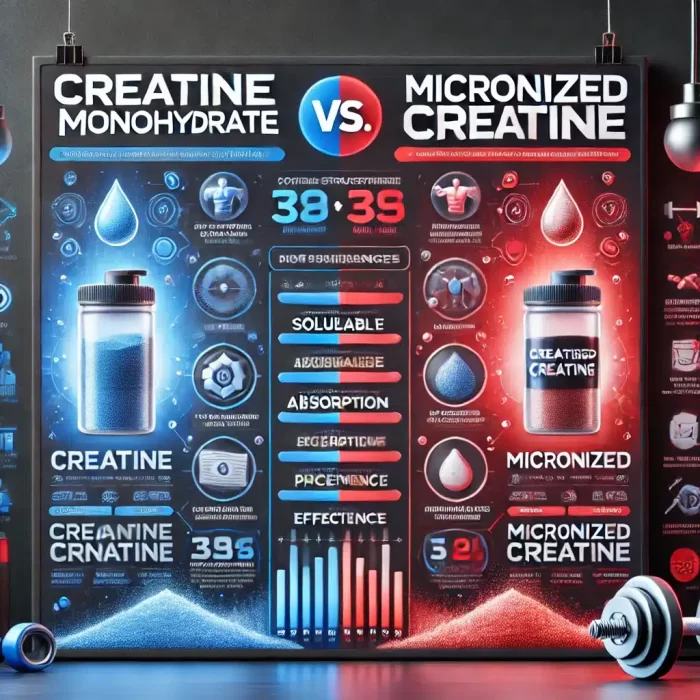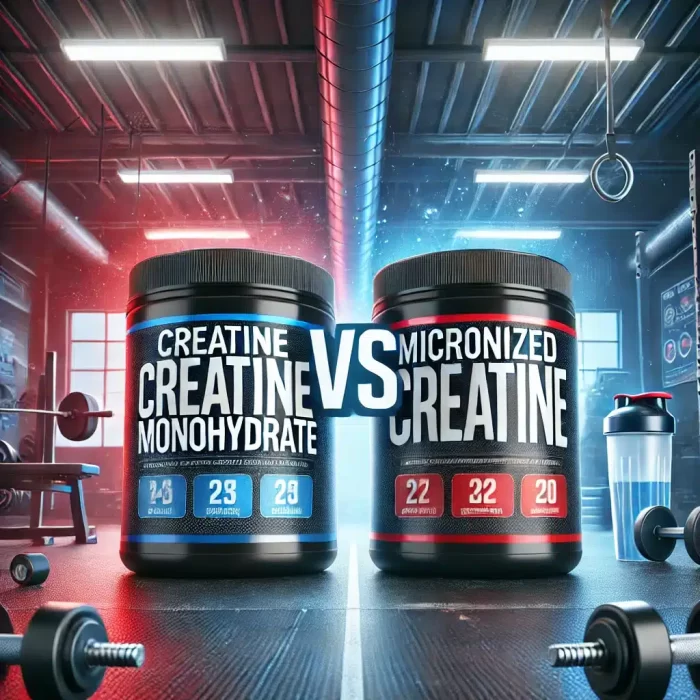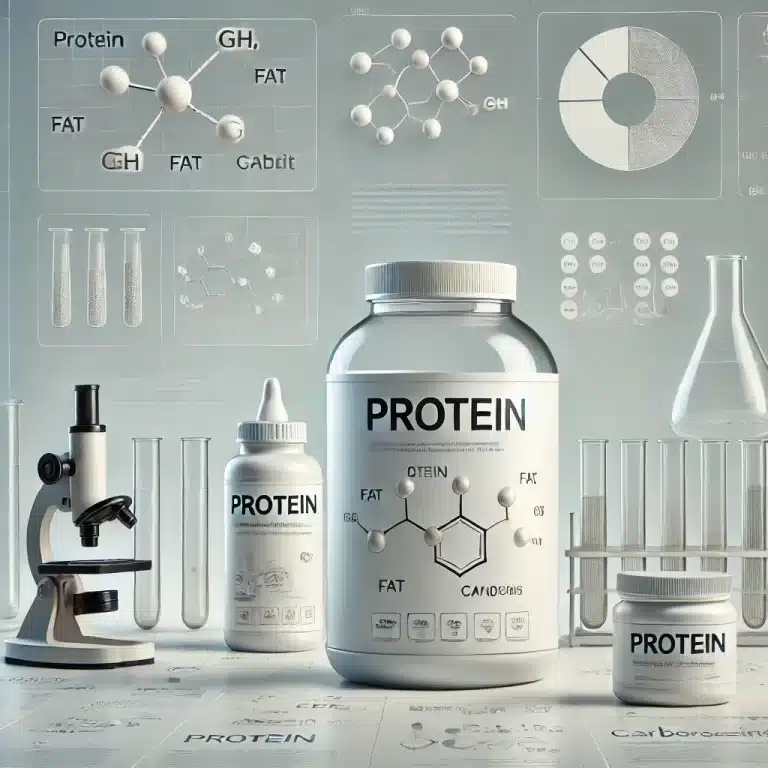Creatine Monohydrate vs. Micronized Creatine: Small Differences, Big Impact?
If you’ve ever stepped into the world of fitness supplements, you’ve probably heard of creatine. It’s the go-to supplement for boosting muscle growth, enhancing strength, and improving workout performance. But when it comes to choosing the right type, things can get a little confusing. Two of the most popular forms, Creatine Monohydrate Vs. Micronized Creatine, promises similar benefits, but do the differences matter?
Think of it like this: imagine two cars with the same powerful engine, but one has an upgraded fuel system that makes it slightly more efficient. That’s the kind of difference we’re talking about between these two creatine types.
In this article, we’ll break down what makes them different, who should use which, and which one might be the better choice for you. Whether you’re new to creatine or just trying to optimize your gains, we’ve got you covered with all the details without the fluff. Let’s get into it!
What is Creatine?
Creatine is a naturally occurring compound that your body produces in small amounts and stores in muscle cells. It plays a vital role in energy production, particularly during short bursts of high-intensity activities such as weightlifting, sprinting, and explosive movements in sports.
Your body synthesizes creatine from amino acids, arginine, glycine, and methionine, primarily in the liver, kidneys, and pancreas. Once produced, creatine is stored in muscle tissue as phosphocreatine, which helps regenerate adenosine triphosphate (ATP), the primary energy source for muscle contractions.
How Does Creatine Work?
During intense exercise, your muscles rapidly deplete ATP, which provides the energy needed for muscle contractions. Once ATP is used, it breaks down into adenosine diphosphate (ADP), which is less effective for energy production. Creatine steps in by donating a phosphate group to ADP, converting it back into ATP, allowing muscles to sustain high-power output for longer periods.
Why Supplement with Creatine?
While creatine is found naturally in foods like red meat, poultry, and fish, the amount obtained from diet alone is often insufficient for achieving optimal muscle saturation. Supplementing with creatine ensures that your muscles maintain higher phosphocreatine stores, leading to improved performance and faster recovery.
Key Benefits of Creatine:
- Increased Muscle Mass: Enhances water retention in muscle cells, promoting growth and volumization.
- Enhanced Strength and Power: Provides immediate energy for explosive movements, improving overall performance.
- Faster Recovery: Helps reduce muscle cell damage and inflammation, leading to quicker post-workout recovery.
- Cognitive Benefits: Some studies suggest creatine may support brain function, improve focus, and reduce mental fatigue.
- Greater Workout Intensity: With more ATP available, you can train harder and longer, leading to greater gains over time.
Who Can Benefit from Creatine?
Creatine supplementation is not just for bodybuilders or powerlifters. It benefits:
- Athletes who require short bursts of intense effort (e.g., sprinters, football players, basketball players).
- Weightlifters and those focusing on muscle hypertrophy and strength training.
- Endurance athletes who want to improve recovery between workouts.
- Older adults seeking to maintain muscle mass and cognitive function.
While creatine is widely recognized as one of the safest and most effective supplements available, its effectiveness can vary depending on the type of creatine used. That brings us to the debate: Creatine Monohydrate vs. Micronized Creatine, which one is right for you?
Creatine Monohydrate: The Powerhouse of Performance

What Makes Creatine Monohydrate the Go-To Choice?
Creatine Monohydrate has stood the test of time as the most trusted and scientifically backed form of creatine. It consists of creatine combined with a single water molecule, ensuring high purity and effectiveness. Fitness enthusiasts and athletes have relied on it for years to enhance strength, endurance, and muscle growth.
Why Choose Creatine Monohydrate? The Top Benefits
- Proven Effectiveness: Decades of research support its ability to increase muscle strength and endurance.
- Cost-Effective: One of the most affordable and widely available forms of creatine.
- Increases Muscle Hydration: Promotes cell volumization, leading to muscle growth.
- Easy to Use: Available in various forms, including powder, capsules, and tablets.
Are There Any Downsides?
- Mixability Challenges: Due to its particle size, Creatine Monohydrate can sometimes leave a gritty texture when mixed in cold water. Stirring well or using warm liquids can help dissolve it more efficiently. It may not dissolve completely in water, leading to a gritty texture.
- Possible Water Retention: Some users may experience minor bloating due to increased water retention in muscles, which is generally harmless and temporary. Some users experience minor bloating due to water retention.
Micronized Creatine: The Cutting-Edge Boost for Peak Performance
Why Micronized Creatine is a Game-Changer
Micronized Creatine takes the power of traditional creatine monohydrate and enhances it with advanced processing. By breaking it down into ultra-fine particles, micronized creatine offers superior solubility, allowing for effortless mixing in liquids. This improvement not only prevents clumping and grittiness but may also promote faster absorption, making it more readily available for muscle cells.
Top Benefits of Micronized Creatine
- Dissolves Instantly: Unlike regular creatine, micronized creatine dissolves effortlessly in water, eliminating grittiness and residue. Mixes more easily in water, reducing clumping and grittiness.
- Gentle on Digestion: Many users report fewer stomach issues and reduced bloating compared to regular creatine monohydrate, making it a great option for those with sensitive digestion. Some users find that micronized creatine is gentler on digestion, potentially reducing bloating and discomfort.
- Faster Absorption: The smaller particle size enhances uptake in muscle cells, potentially leading to quicker results in terms of strength and endurance gains. The smaller particle size may allow for faster absorption into muscle cells, ensuring quicker availability for performance benefits. And since it dissolves more easily and may be easier on digestion, it could be a better option before bed, especially if you have a sensitive stomach.
Any Drawbacks to Consider?
- Slightly More Expensive: The extra processing involved in micronization adds to the cost, making it pricier than standard creatine monohydrate. Due to additional processing, micronized creatine tends to cost more than standard creatine monohydrate.
- Comparable Performance to Monohydrate: Despite the improved mixability, research suggests that the muscle-building and strength-enhancing effects remain nearly identical to traditional creatine monohydrate. Despite improved solubility, research suggests that performance outcomes are comparable to regular creatine monohydrate.
When is Creatine Monohydrate the Best Choice?
Creatine Monohydrate is the go-to choice for many athletes, bodybuilders, and fitness enthusiasts due to its affordability, extensive research backing, and reliable performance benefits. If you’re someone who values proven results at a budget-friendly price, this form of creatine is ideal.
You Should Choose Creatine Monohydrate If:
- You want the most cost-effective option: It provides the same muscle-building and strength-boosting benefits as other forms but at a lower price.
- You’re looking for the most scientifically backed creatine: Decades of research confirm its effectiveness in increasing power, endurance, and lean muscle mass.
- You don’t mind slightly lower solubility: While it may not dissolve as easily as micronized creatine, stirring it well or mixing it with warm water can help.
- You’re new to creatine supplementation: If you’re just starting, it’s best to go with the form that has the most research and real-world success.
- You want a simple, no-frills supplement: With no added processing or alterations, Creatine Monohydrate is pure, reliable, and easy to incorporate into your routine.
How to Maximize Creatine Monohydrate’s Effectiveness?
- Mix it properly: To reduce grittiness, dissolve it in warm water or a shake.
- Pair it with carbs: Taking creatine with a carbohydrate source may enhance absorption.
- Stay hydrated: Creatine draws water into muscle cells, so drink plenty of fluids to prevent dehydration.
- Take it consistently: Regular use is key to seeing long-term benefits in muscle strength and endurance.
When Should You Use Micronized Creatine?
Micronized Creatine is the perfect fit for those who want an ultra-smooth, easy-to-mix supplement without compromising on effectiveness. If you’ve ever struggled with gritty creatine or experienced bloating from traditional monohydrate, this refined version might be exactly what you need. While it carries a slightly higher price tag, the benefits of mixability, digestion, and ease of use make it a strong contender for those looking to enhance their fitness routine without any hassle.
Who Should Consider Micronized Creatine?
- You experience bloating or stomach discomfort with regular creatine: The finer particles of micronized creatine may make it easier to digest, reducing the chances of bloating or gastric distress.
- You struggle with mixing traditional creatine monohydrate: If you’ve ever dealt with clumpy or gritty creatine that settles at the bottom of your glass, micronized creatine offers a seamless, residue-free mix.
- You prefer a smoother drinking experience: Micronized creatine dissolves almost instantly, making it an excellent option for those who dislike the texture of standard creatine monohydrate.
- You’re willing to pay a little extra for better solubility: While micronized creatine is slightly more expensive, the benefits of improved mixability and potential digestive comfort may be worth it for some users.
- You want the fastest possible absorption: Though research suggests both forms are equally effective, some believe the smaller particles of micronized creatine allow for quicker absorption in muscle cells.
Tips to Maximize the Benefits of Micronized Creatine
- Choose the right beverage – Unlike traditional creatine monohydrate, micronized creatine dissolves effortlessly in cold water, juice, or even protein shakes, ensuring a smooth, residue-free drink.
- Make it a daily habit – Whether taken pre- or post-workout, consistency is key. Taking it at the same time every day helps ensure your muscles remain saturated with creatine for peak performance.
- Hydration is essential – Creatine draws water into your muscles, so staying well-hydrated prevents dehydration and optimizes your results. Just like regular creatine, staying hydrated will help optimize muscle absorption and minimize potential side effects.
- Boost absorption with carbs – Combining creatine with a carbohydrate source, such as a post-workout meal, can improve uptake and utilization by muscle cells, maximizing its effectiveness.
Side-by-Side Comparison
| Feature | Creatine Monohydrate | Micronized Creatine |
|---|---|---|
| Effectiveness | Proven & well-researched | Can be gritty, and takes time to dissolve |
| Solubility | Mixes easily, with no residue | Mixes easily, no residue |
| Digestibility | May cause minor bloating in some users | Gentler on the stomach |
| Cost | More affordable | Slightly more expensive |
| Availability | Widely available | Less common than monohydrate |
How to Take Creatine for Best Results?
Regardless of which type you choose, here’s how to maximize its benefits:
- Loading Phase (Optional): Take 20g per day (split into 4 doses) for 5-7 days to saturate muscles faster.
- Maintenance Dose: 3-5g per day to maintain creatine levels.
- Best Timing: Can be taken pre- or post-workout; consistency is more important than timing.
- Mixing Tips: Use warm water or a shake to help dissolve creatine better.
- Pairing with Carbs: Consuming creatine with a carbohydrate source may improve absorption.
- Stay Hydrated: Creatine pulls water into muscles, so drink plenty of water throughout the day.
FAQs About Creatine Monohydrate and Micronized Creatine
Which type of creatine is best for beginners?
Creatine monohydrate is the best option for beginners due to its affordability, proven research, and effectiveness. It provides all the benefits needed to boost performance without extra cost.
Is one type of creatine more effective than the other?
Both creatine monohydrate and micronized creatine offer similar performance benefits. Micronized creatine may be easier to digest and mix, but monohydrate is more affordable and widely available.
Which Is Better for You: Micronized Creatine Vs. Monohydrate?
Choosing between Creatine Monohydrate and Micronized Creatine comes down to personal preference, budget, and how your body reacts to each form. Both are proven to enhance muscle strength, size, and recovery, but they cater to different user needs.
- Go with Creatine Monohydrate if you want the most affordable, research-backed option with proven effectiveness for muscle growth and performance.
- Choose Micronized Creatine if you prefer faster mixing, a smoother texture, and potentially easier digestion, even if it costs a little more.
- Final Verdict: No matter which you choose, creatine remains one of the most effective and safest supplements for improving workout performance. The key is consistency whichever form you decide on, taking it daily will yield the best results.






